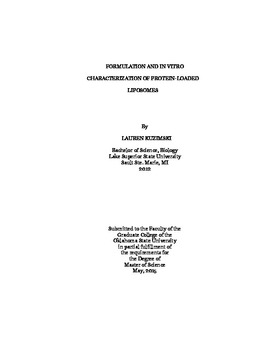| dc.contributor.advisor | Ranjan, Ashish | |
| dc.contributor.author | Kuzimski, Lauren Nicole | |
| dc.date.accessioned | 2016-09-29T18:35:30Z | |
| dc.date.available | 2016-09-29T18:35:30Z | |
| dc.date.issued | 2015-05-01 | |
| dc.identifier.uri | https://hdl.handle.net/11244/45177 | |
| dc.description.abstract | Background/Objective: Protein-based drugs are increasingly used to treat a variety of conditions including cancer and cardio-vascular disease. Due to the immune system�s innate ability to degrade the foreign particles quickly, protein-based treatments are generally short-lived. To address this limitation, the objective of the study was to: 1) develop protein-loaded liposomes; 2) characterize size, stability, encapsulation efficiency and rate of protein release; and 3) determine intracellular uptake and distribution; and 4) protein structural changes.Method: Liposomes were loaded with a fluorescent-albumin using freeze-thaw (F/T) methodology. Albumin encapsulation and release were quantified by fluorescence spectroscopic techniques. Flow cytometry was used to determine liposome uptake by macrophages. Epifluorescence microscopy was used to determine cellular distribution of liposomes. Stability was determined using dynamic light scattering by measuring liposome size over one month period. Protein structure was determined using circular dichroism (CD).Result: Encapsulation of albumin in liposome was ~90% and was dependent on F/T rates, with fifteen cycles yielding the highest encapsulation efficacy (p < 0.05). Albumin-loaded liposomes demonstrated consistent size (<300nm). Release of encapsulated albumin in physiological buffer at 25�C was ~60% in 72 h. Fluorescence imaging suggested an endosomal route of cellular entry for the FITC-albumin liposome with maximum uptake rates in immune cells (30% at 2hour incubation). CD suggested protein structure is minimally impacted by freeze-thaw methodology.Conclusion: Using F/T as a loading method, we were able to successfully achieve a protein-loaded liposome that was under 300nm, had encapsulation of ~90%. Synthesized liposomes demonstrated a burst release of encapsulate protein (60%) at 72 hours. Cellular trafficking confirmed endosomal uptake, and minimal protein damage was noticed in CD. | |
| dc.format | application/pdf | |
| dc.language | en_US | |
| dc.rights | Copyright is held by the author who has granted the Oklahoma State University Library the non-exclusive right to share this material in its institutional repository. Contact Digital Library Services at lib-dls@okstate.edu or 405-744-9161 for the permission policy on the use, reproduction or distribution of this material. | |
| dc.title | Formulation and in Vitro Characterization of Protein-loaded Liposomes | |
| dc.type | text | |
| dc.contributor.committeeMember | Pope, Carey | |
| dc.contributor.committeeMember | Liu, Jing | |
| dc.contributor.committeeMember | Hartson, Steve | |
| dc.contributor.committeeMember | Ramsey, Josh | |
| osu.filename | Kuzimski_okstate_0664M_14055.pdf | |
| osu.accesstype | Open Access | |
| dc.description.department | Veterinary Biomedical Sciences | |
| dc.type.genre | Thesis | |
